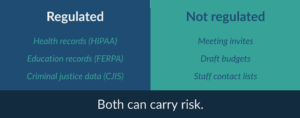Week 1 | Week 2
Understanding the Difference
In public sector cybersecurity, one of the most common questions is: “Does this data need to be protected?”
The short answer: Yes—if it can be misused, it should be protected.
Government agencies and their vendors handle both regulated data—information protected by law—and unregulated data, which may seem routine but can still create serious risk if exposed. GovRAMP helps organizations protect both by setting consistent, trusted security standards across the public sector.
What Is Regulated Data in Cybersecurity?
Regulated data is information with legal protection and strict handling requirements.
In the public sector, examples include:
Mishandling this type of data can result in fines, legal action, and loss of public trust.
What Is Unregulated Data—and Why It’s Still Risky
Unregulated data does not have explicit legal protections, but it can still reveal operational or sensitive details.
Examples include:
-
Internal meeting notes
-
Staff schedules and calendars
-
Draft budgets or policy documents
-
Spreadsheets with embedded credentials
Attackers aren’t looking for legal definitions—they’re looking for opportunities. Even without a compliance requirement, this information can be exploited to gain access or insight into your systems.
How Attackers Exploit Non-Regulated Data
Cyber incidents often happen when an external threat meets an internal vulnerability. Unregulated data can be that vulnerability. For example:
-
A calendar invite that contains secure meeting links
-
A shared document with sensitive access notes
-
A public-facing folder left with default permissions
These exposures may not trigger compliance alarms, but they can create real, avoidable risks.

GovRAMP’s Role in Protecting All Data
GovRAMP provides a standardized approach to security for cloud service providers and government agencies—ensuring protections extend beyond just regulated categories.
Our security statuses create a trusted baseline, so agencies know which solutions meet rigorous security requirements before procurement.
By applying consistent controls across all types of data, GovRAMP helps:
-
Reduce vulnerabilities
-
Improve vendor evaluation
-
Support faster, safer technology adoption
-
Protect public trust
Best Practices for Securing Every Type of Information
Whether regulated or not, treat all data with care. Start with these steps:
-
Apply access controls to every document, not just regulated ones
-
Remove outdated files from systems and storage
-
Avoid casual sharing of credentials or internal notes
-
Use vendors that meet trusted security standards like GovRAMP
Why This Matters
Public sector cybersecurity isn’t just about protecting systems—it’s about protecting people. When agencies safeguard both regulated and unregulated information, they protect service continuity, operational integrity, and the citizens they serve.
If it can be misused, it is a risk.
Risk-aware teams protect it—regulated or not.
Frequently Asked Questions
Q: What is the difference between regulated and unregulated data?
A: Regulated data has legal protections (e.g., HIPAA, FERPA, CJIS). Unregulated data is not protected by law but can still cause harm if exposed.
Q: Does GovRAMP cover both regulated and unregulated data?
A: GovRAMP’s standards focus on reducing vulnerabilities across all types of data—ensuring agencies and providers protect more than just what is required by law.

